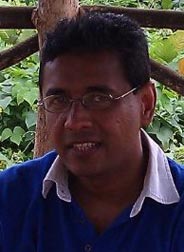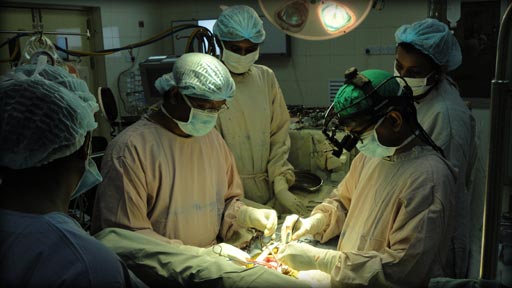A beat out of sync
Nearly 3,000 children born with congenital Heart
Diseases in Sri Lanka every year:
For every 1,000 newborns there are 6-8 born with Congenital Heart
Disease (CHD), according to the Sri Lanka Heart Association. Going by
the 2005 statistics of live births, close to 3,000 children are born
with CHD each year. Here Consultant Paediatric Cardiologist, Lady
Ridgeway Hospital, Dr Duminda Samarasinghe explains the different types
of CHD, early detection, causes and treatment.
Excerpts...
|

Dr Duminda Samarasinghe |
Q: Congenital heart diseases are said to be rising in Sri
Lanka. Compared with a decade ago, what do you estimate to be the
increase?
A: There is no evidence to say that it is rising. I think it
is getting detected more due to improved healthcare. For example, when I
started my training about 10 years back, a patient with Transposition of
Great Arteries (where the two main blood vessels arise from the opposite
ventricle) would be referred to us only once a month. But now we are
seeing one to two patients every week. We have also observed that from
centres where there is a Paediatric Cardiologist, we get more complex
patients referred for surgery. This clearly indicates that the rise is
due to better detection through better awareness.
Q: Since many parents are still unaware of congenital heart
diseases, tell us what it means?
A: A congenital heart disease is a problem in the heart that
is there from birth. One cannot get a congenital heart disease later in
life but it can get detected later in life. People commonly call it a
hole in the heart but it is only one type. There are many other types of
congenital heart diseases.
Q: Are there different types of CHD that a child can have?
What are they?
A: The commonest category of CHD is holes in the heart or
otherwise named as shunt lesions. A hole in the wall between the two
upper chambers (inter atrial septum) is called an Atrial Septal Defect (ASD)
and the hole in the wall between the two lower chambers of the heart (interventricular
septum) is called a Ventricular Septal Defect (VSD). These are further
subdivided depending on the exact location in the septum. A hole or a
communication between two main blood vessels (aorta and pulmonary
artery) is called a Patent Ductus Arteriosus (PDA). All these holes
cause blood to flow from left side of the heart to right. As right sided
chambers pump blood to the lungs, this causes an increase in the volume
of blood that goes in to the lungs. Even though there is a hole, as left
sided pressure is higher than that of the right side, blue blood does
not cross from right side to left. Therefore these children are not
blue.
The second category of CHD is a narrow valve or a narrow blood vessel
arising from the heart which is also called a stenotic lesion. In these
lesions there is no mixing of blood but due to narrowing of the valve or
the vessel there is rise in the pressure of the proximal chamber.
The third and more complex category is called cyanotic congenital
heart diseases as these children become blue due to crossing over of
blue blood in the right side of the heart to the left side of the heart
and then in to the body.
As this blood has lesser amount of oxygen, it appears blue and when
it reaches the extremities of the body and mucous membranes where we can
see the blood through relatively thin skin,
|

Prof.Rajeev BhargavaA surgical procedure in progress |
Q: How do these abnormalities occur? What causes them?
A: For most of the lesions there is no clear cause. But some
may be a part of a syndrome like Down Syndrome. Certain maternal
infections during pregnancy like Rubella and some medications taken
during pregnancy can cause certain CHD. Maternal alcohol abuse, which is
rare in Sri Lanka, also can cause this.
Q: When do these abnormalities manifest? During pregnancy? In
the first few months or years after birth? Or later?
A: CHD diseases can manifest at any age depending on severity
and how vigilant the parents and primary care doctors are. Some of them
with significant bluish discoloration (cyanosis) will be detected by the
parents and doctors very easily. But if the cyanosis is only mild, there
is a chance of it getting missed easily. During anomalies, certain heart
lesions can get detected in scans done during pregnancy. Some parents
expect that all lesions will be detected during these anomalies scan,
but unfortunately it is not so.
Q: What are the symptoms to look for?
A: Depending on the lesion, symptoms may vary. If it is a
simple hole in the heart (shunt lesion) the child can become breathless
due to high flow of blood to the lungs. He will also have a higher heart
rate. They will develop frequent chest infections and will not gain
weight. There will be head sweating on slightest exertion.
Children with obstructive lesions are relatively asymptomatic until
the last stages. Sometimes they might faint after exertion.
Children with more complex lesions can have symptoms of a shunt
lesion (described above) if they have high blood flow to the lungs or
can be significantly blue if they have low blood flow to the lungs.
Q: Does contracting German measles (rubella) during pregnancy
carry a heart risk for the baby?
A: Yes there is always a risk. But that does not mean every
mother who gets rubella will deliver a baby with a CHD. Thanks to the
Rubella immunization the incidence of maternal Rubella is also very low
now.
Q: Will getting the Rubella vaccine for school girls also
prevent congenital heart risks that may be associated with the disease?
A: Definitely yes. Rubella infection during pregnancy is
associated with CHD in the foetus. Those who have had the vaccination as
school girls are least likely to get Rubella infection during pregnancy.
Q: Do genes play a role in congenital heart diseases?
A: For most of the CHD there is no genetic basis. However
there is an indirect relationship of CHD and cousin marriages. When
related individuals marry there is a risk of getting babies with various
dysmorphic syndromes.
Those syndromes have their own associated CHDs. Therefore, there is a
higher risk of getting babies born with CHD after marrying blood related
individuals.
Q: How is CHD treated/managed?
A: Most of the CHD need either surgical or catheter based
intervention. Drugs are only used as an interim measure to control
symptoms until they get definitive treatment.
Q: Is CHD curable? Reversible?
A: Some of the CHD can be cured with surgery or catheter based
interventions. But most of them will need long term follow up even after
surgery or catheter based interventions to look for development of late
complications. CHDs are not reversible without surgery or intervention.
Q: At present what kind of facilities can Sri Lanka offer for
children with heart problems?
 A:
The main institution that treats children with heart diseases is the
Lady Ridgeway Hospital for Children. Here, we have facilities to treat
almost all CHDs except the very complex ones. However, there is an issue
with the numbers that we can handle as we have limited resources. We
perform approximately 1000 cardiac surgeries and 700 catheter based
interventions every year on children born with CHD (around 3000
children) and also older patients who have not received any treatment
and some patients need 2-3 surgeries in their lifetime to correct the
lesion. At present we can handle only 50-60% of the patient load with
CHD. Our target should be to treat the balance 40% as well. A:
The main institution that treats children with heart diseases is the
Lady Ridgeway Hospital for Children. Here, we have facilities to treat
almost all CHDs except the very complex ones. However, there is an issue
with the numbers that we can handle as we have limited resources. We
perform approximately 1000 cardiac surgeries and 700 catheter based
interventions every year on children born with CHD (around 3000
children) and also older patients who have not received any treatment
and some patients need 2-3 surgeries in their lifetime to correct the
lesion. At present we can handle only 50-60% of the patient load with
CHD. Our target should be to treat the balance 40% as well.
Q:How?
A: We have drawn a detailed development plan to develop this
service in the most cost effective way at the Lady Ridgeway Hospital, to
treat patients from countrywide.
Q: What are some of the essential services and equipment you
need for this?
A: We need more specialists in the field. Surgical expertise
is extremely limited. Number of trained nurses is very limited. We need
to address all these issues and think out of the box to provide a
sustainable and practical solution.
Q: What about equipment?
A: When purchasing equipment, we need to consider the cost as
well as cost effectiveness and lifespan of this mostly electronic
equipment which lasts approximately 7-10years. At the moment we need to
replace some essential equipment, and upgrade most of the equipment that
we use in keeping with technological advances..
Q: Your message to parents?
A: Many parents of children with CHD are often over anxious
and tend to over protect their children. This can lead to behavioural
problems in these children in the long run. There is no need to
overprotect them. They should lead normal lives.
Q: Your message to the community?
A: Most of the parents who have children with CHD are young
and have just started their life. These families need lot of support.
For this we need community support.
To this end, we have Children's Heart Project of Sri Lanka, a
government registered charity, supporting us. We invite the public to
make generous contributions to Children's Heart Project so that they can
help us to keep these young hearts beating. You can get further details
on this by visiting the web page
http://www.childrensheartproject.lk or email us
[email protected] |

